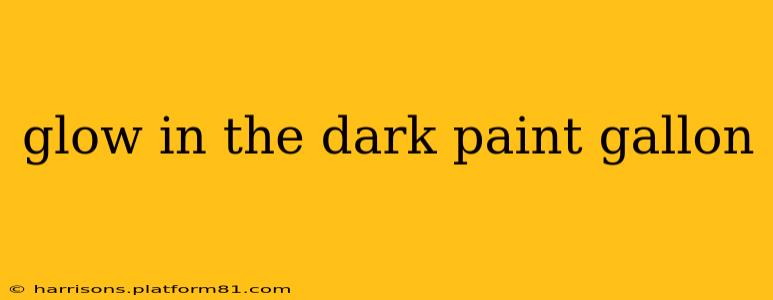Glow-in-the-dark paint has moved beyond novelty; it's a versatile tool for artists, DIY enthusiasts, and safety professionals alike. A gallon of this luminous paint opens up a world of creative possibilities, from dazzling murals to practical nighttime safety markers. But choosing the right gallon of glow paint requires understanding its properties and applications. This comprehensive guide will illuminate the key aspects of choosing and using glow-in-the-dark paint in gallon sizes.
What Makes Glow-in-the-Dark Paint Glow?
Glow-in-the-dark paint relies on a substance called a phosphor. Phosphors are materials that absorb energy (usually light) and then release it slowly as light over time. The brighter the initial light source (like sunlight or a strong UV lamp), the brighter and longer the glow will be. The quality of the phosphor directly impacts the intensity and duration of the glow. Cheaper paints may use lower-quality phosphors, resulting in a weaker and shorter-lived glow.
How Long Does Glow-in-the-Dark Paint Last?
The duration of the glow is a crucial factor. High-quality glow-in-the-dark paints can glow for several hours after being charged with light, while lower-quality paints might only glow for a few minutes. The glow intensity gradually fades over time until it's no longer visible. It's important to understand that the glow isn't permanent; it requires recharging with light to restore its luminosity. Several factors influence glow duration, including:
- Type of phosphor: As mentioned above, higher-quality phosphors offer longer glow times.
- Charging time: The longer the paint is exposed to a light source, the brighter and longer it will glow.
- Environmental factors: Temperature and humidity can affect the glow duration.
What are the Different Types of Glow-in-the-Dark Paint?
Glow-in-the-dark paint comes in various types, each suited for different applications:
- Water-based: Easy to clean up and suitable for most surfaces.
- Acrylic: Offers good durability and adhesion, making it ideal for many projects.
- Oil-based: More durable than water-based options, but requires solvents for cleanup.
- Spray paint: Convenient for large surfaces, but requires proper ventilation.
What are the Best Surfaces for Glow-in-the-Dark Paint?
The best surface for your glow-in-the-dark paint depends on the paint type and the project's requirements. Generally, smooth, non-porous surfaces provide the best glow. However, some paints can adhere to textured surfaces with proper preparation. Always test a small area before applying the paint to a larger surface to ensure proper adhesion and glow intensity.
What are the Safety Precautions for Using Glow-in-the-Dark Paint?
- Ventilation: Always work in a well-ventilated area, especially when using oil-based or spray paints.
- Eye protection: Wear safety glasses to protect your eyes from paint splashes.
- Gloves: Wear gloves to protect your skin from the paint.
- Skin contact: Wash any paint off your skin immediately.
- Disposal: Dispose of paint containers and materials properly according to local regulations.
Is Glow-in-the-Dark Paint Toxic?
Most commercially available glow-in-the-dark paints are non-toxic once dry, but it's always important to check the manufacturer's safety data sheet (SDS) for specific information and handling instructions. Avoid direct skin contact with wet paint, and ensure proper ventilation during application.
Can I Mix Glow-in-the-Dark Paint with Other Paints?
Yes, you can often mix glow-in-the-dark paint with other paints, but this will typically reduce the intensity of the glow. Experimentation is key to finding the right ratio for your desired effect. The type of paint you mix it with also plays a significant role in the final outcome, affecting both color and glow.
How Much Glow-in-the-Dark Paint Do I Need for a Project?
The amount of paint required depends entirely on the project's size and the number of coats needed. A gallon of paint covers a substantial area, making it a cost-effective option for large projects. For smaller projects, consider purchasing smaller quantities to avoid waste. Careful planning and surface area calculations will ensure you have enough paint for your needs.
This guide provides a comprehensive overview of glow-in-the-dark paint in gallon sizes. Remember to always choose high-quality paint and follow safety guidelines for optimal results and a safe working environment. Happy glowing!
